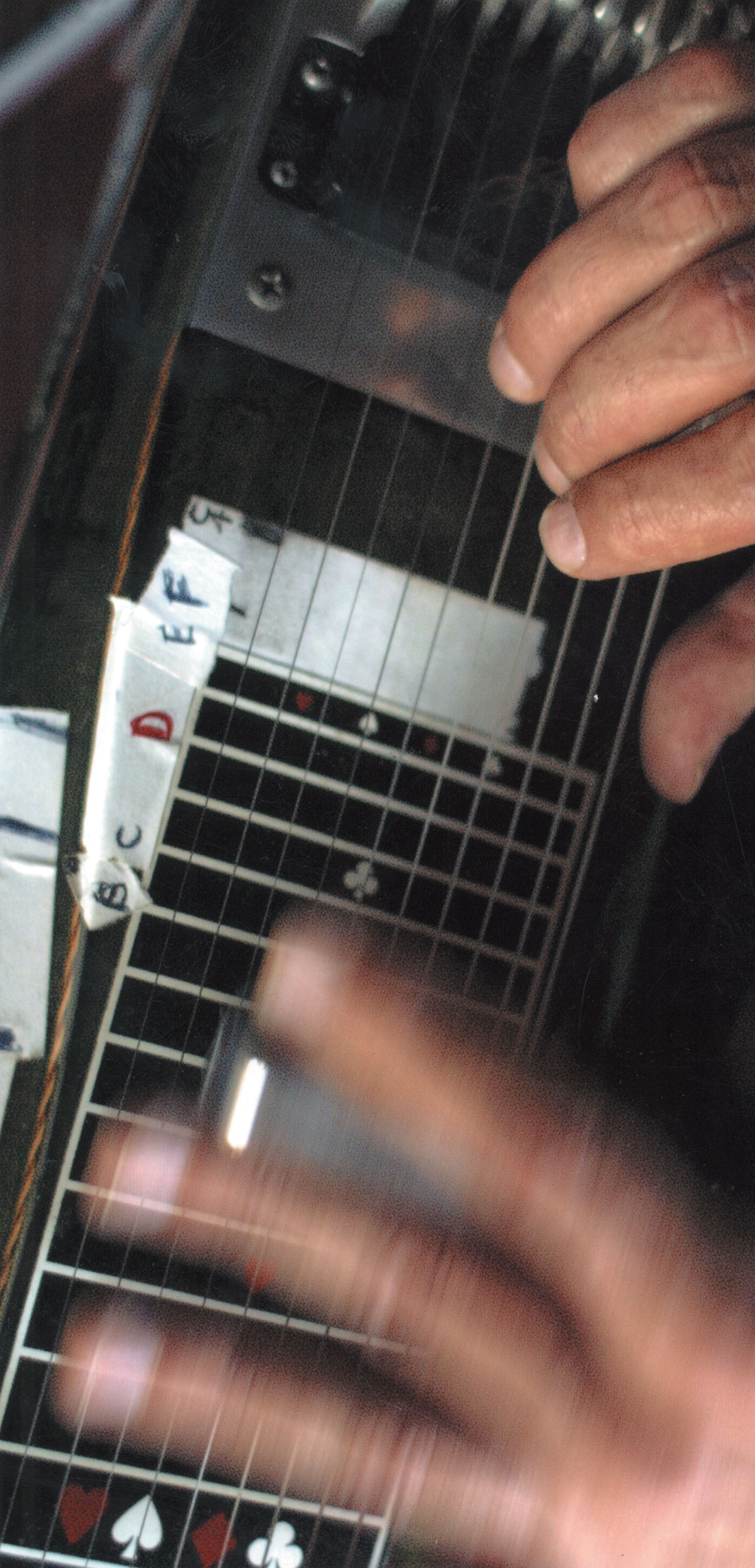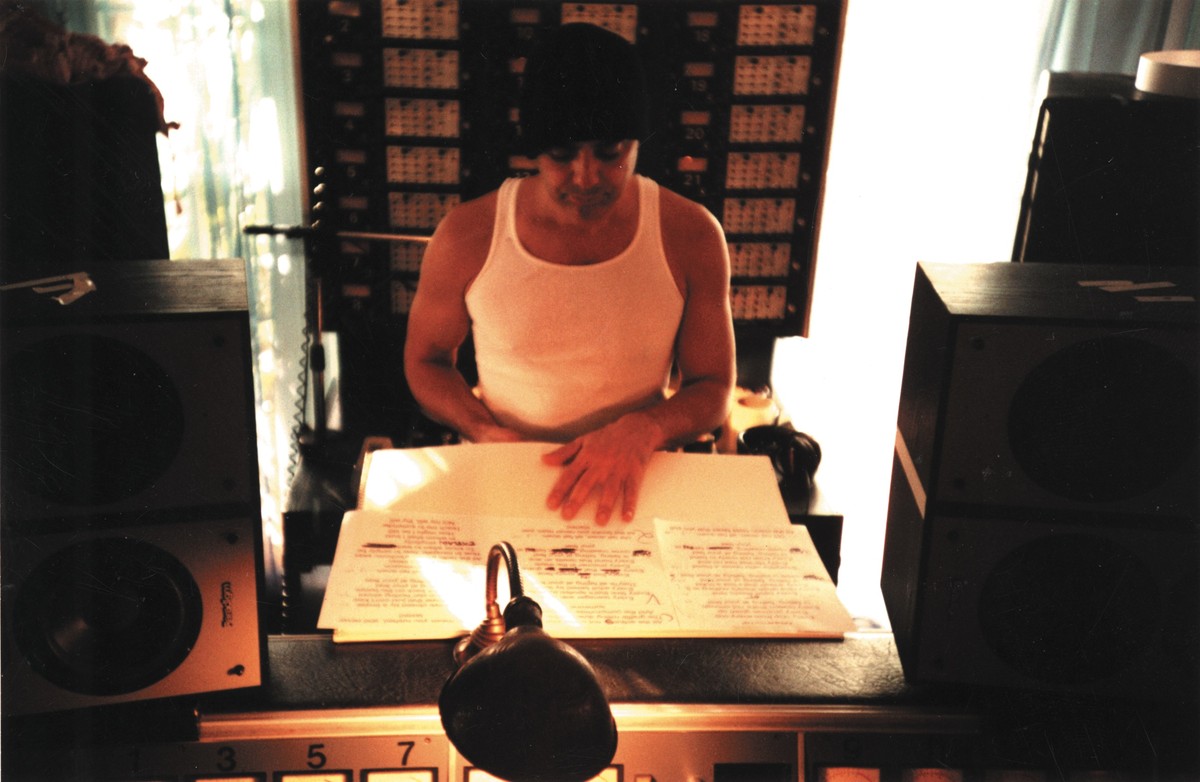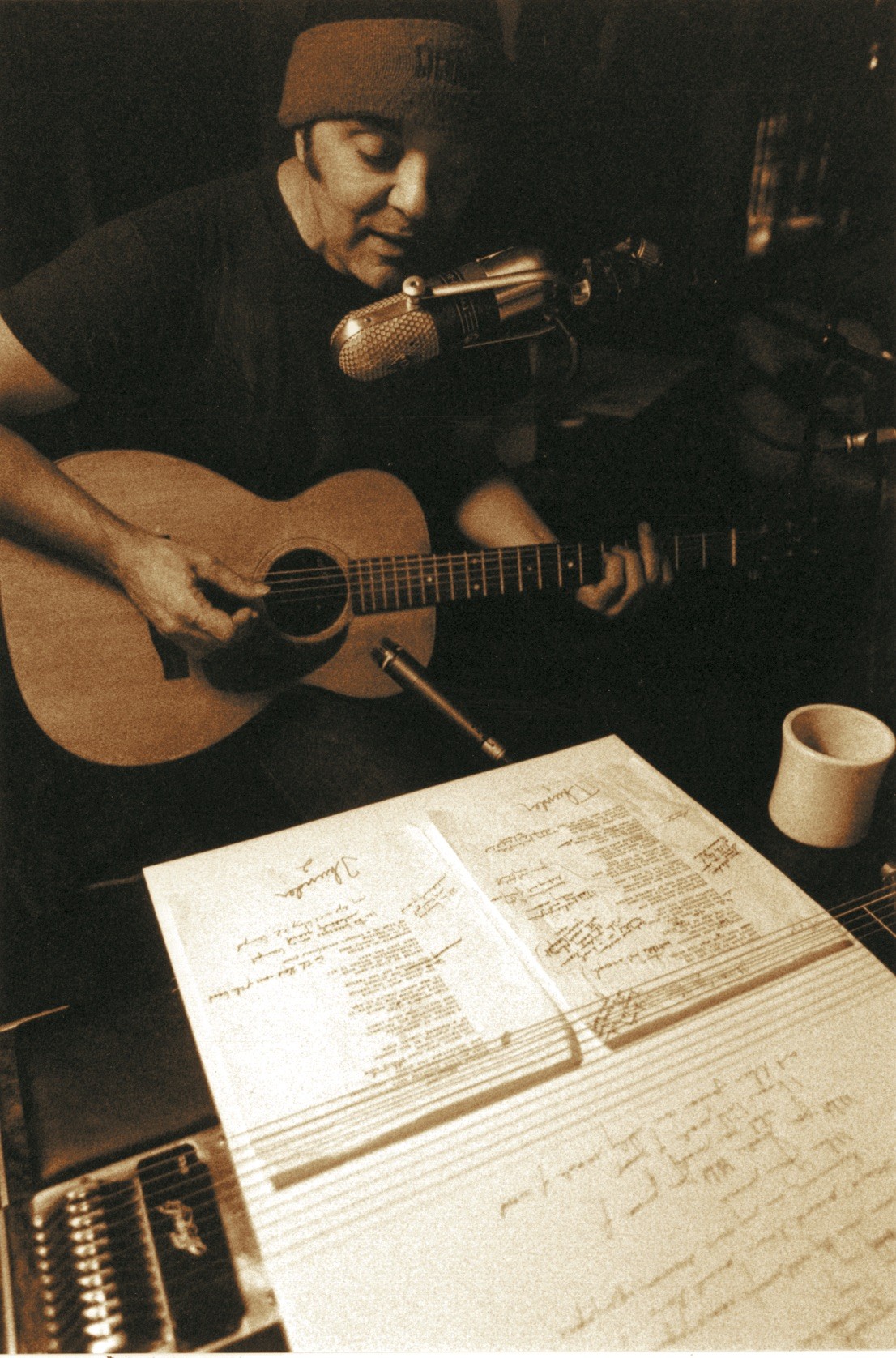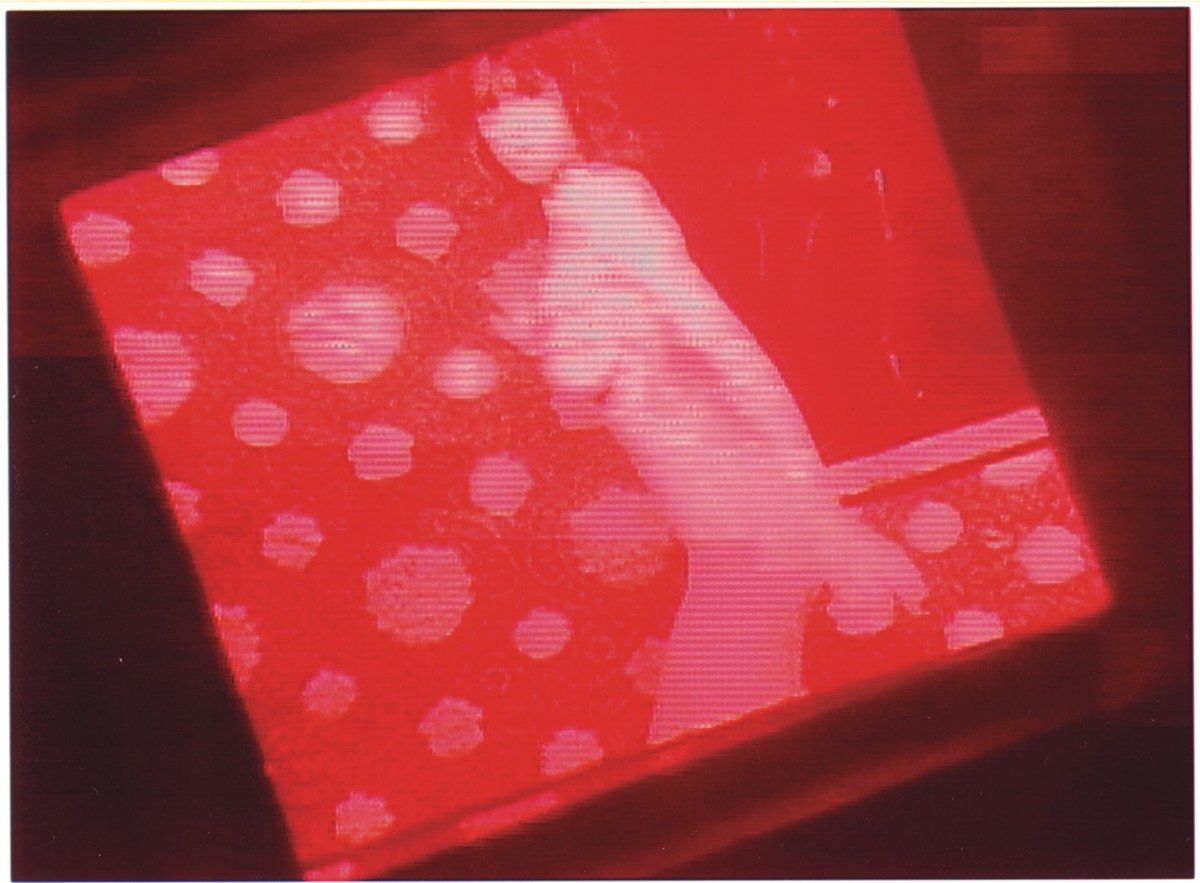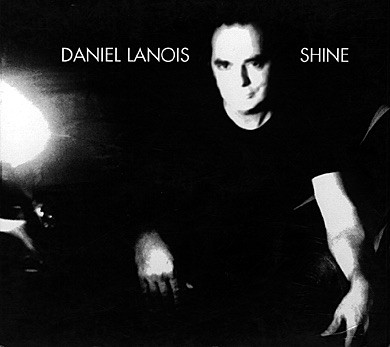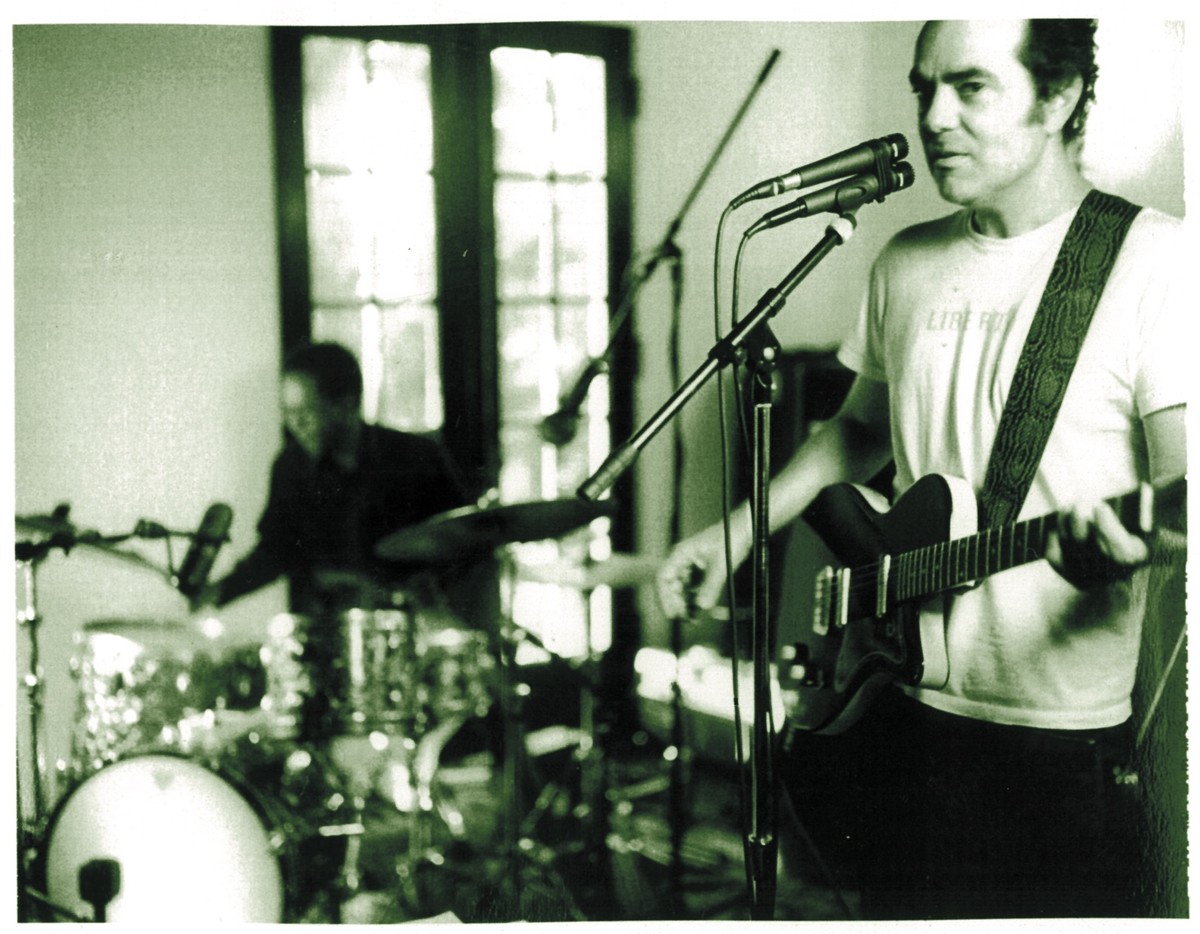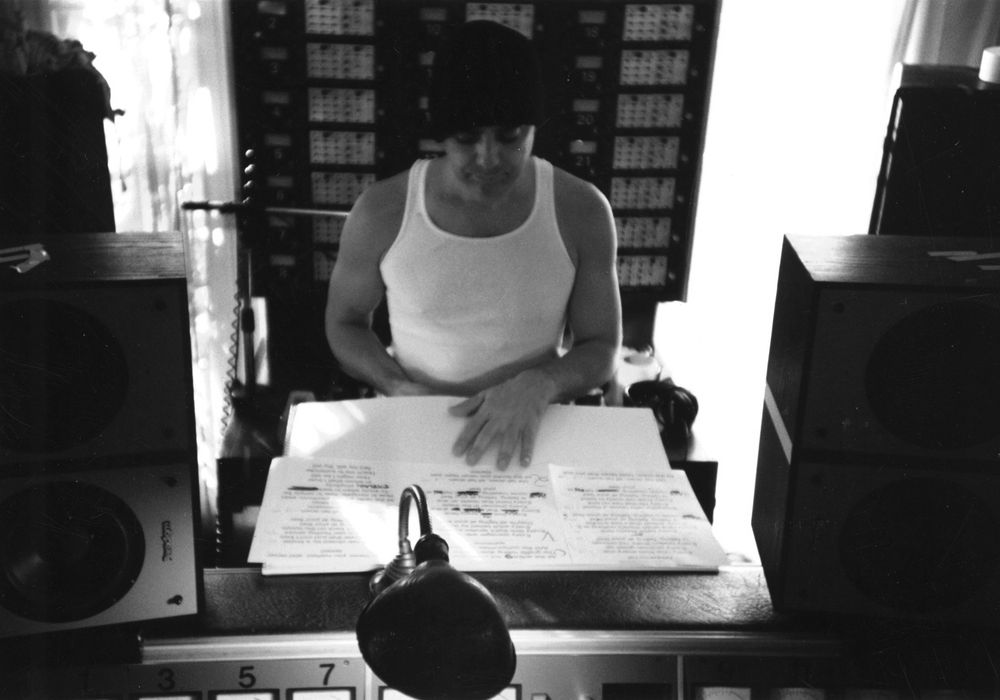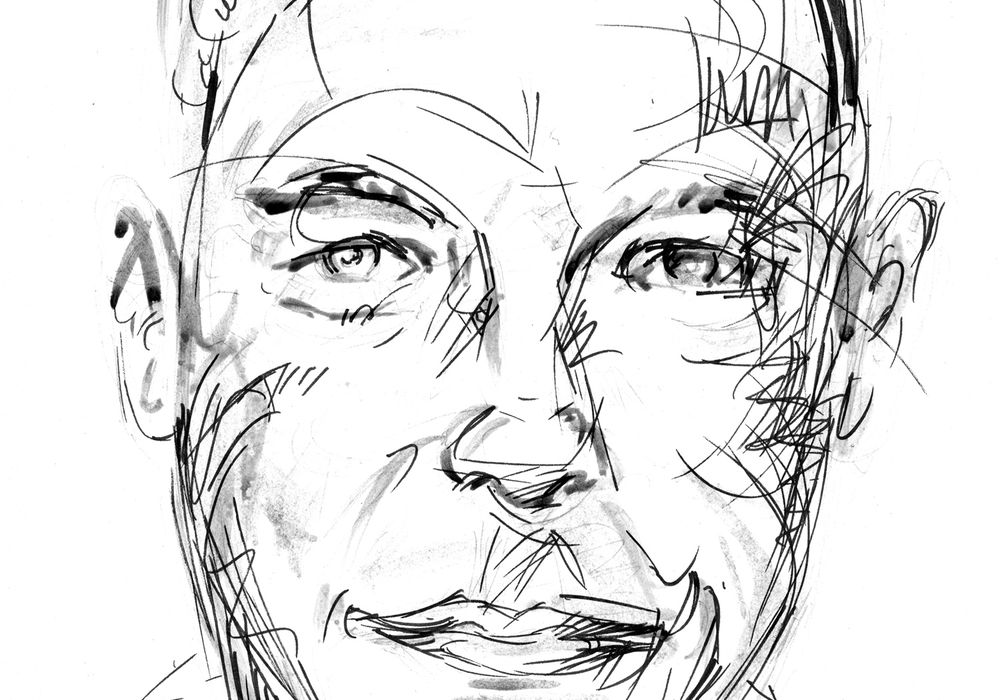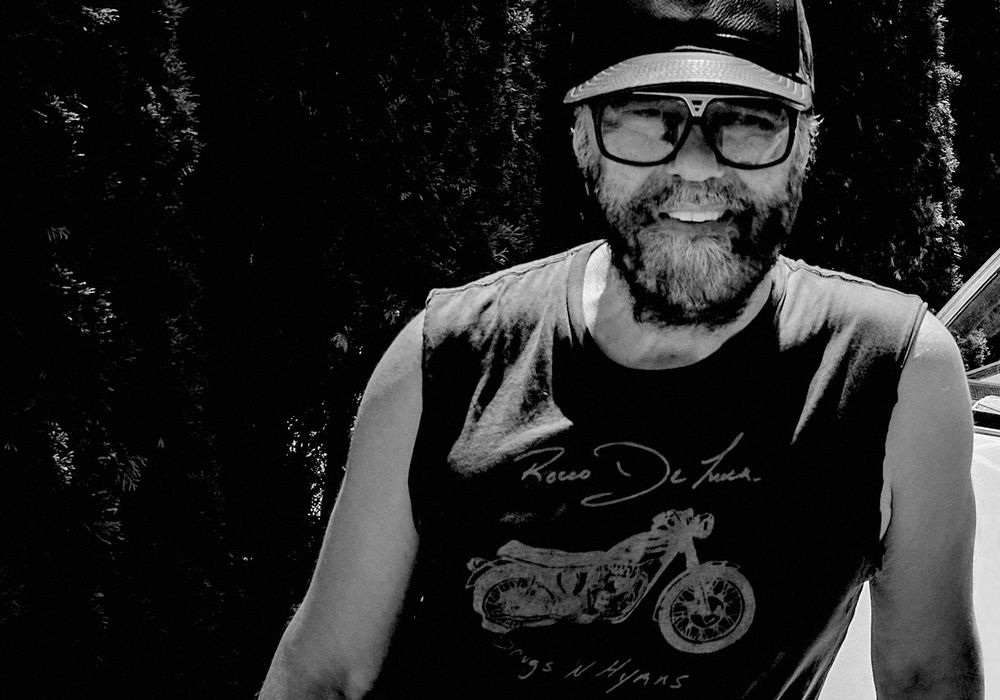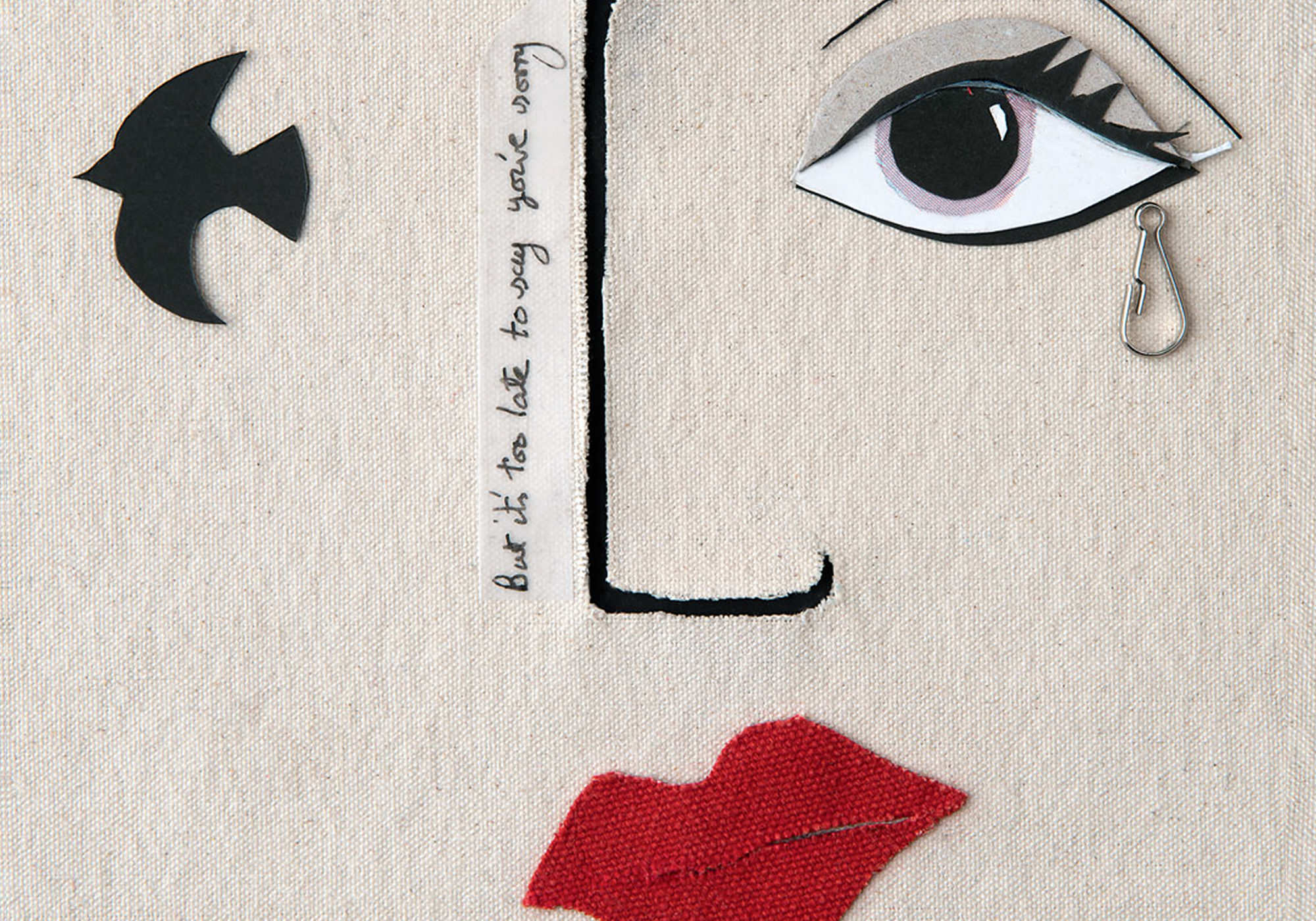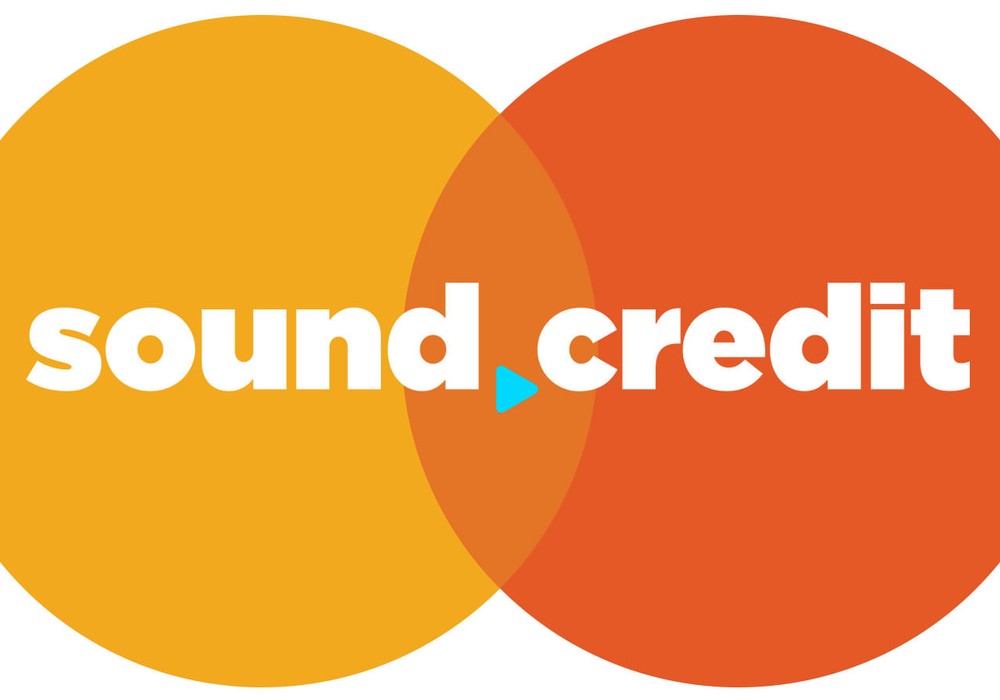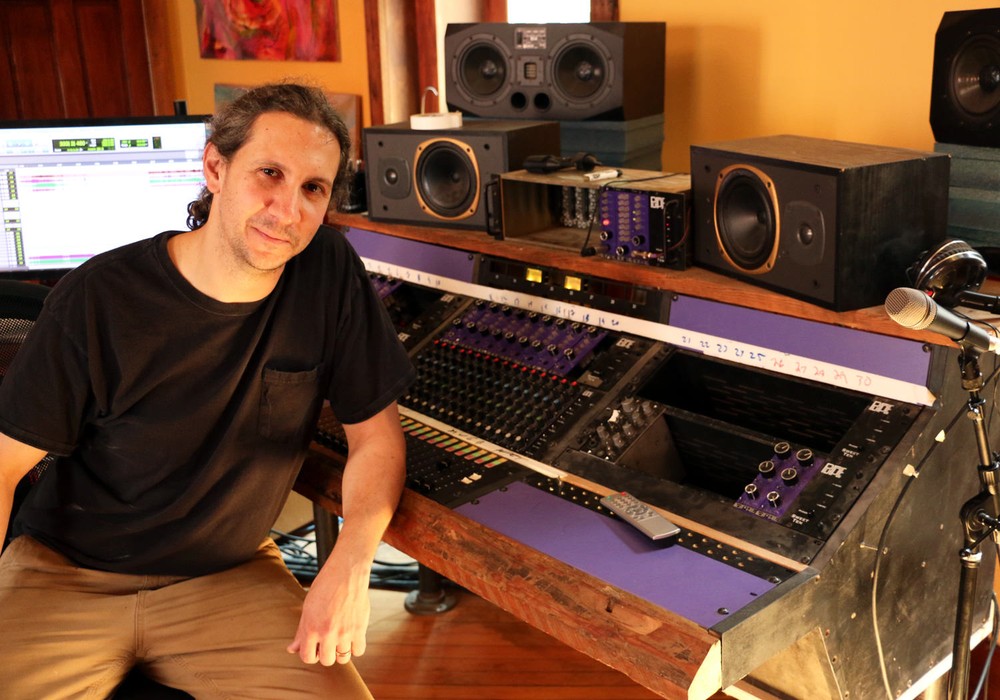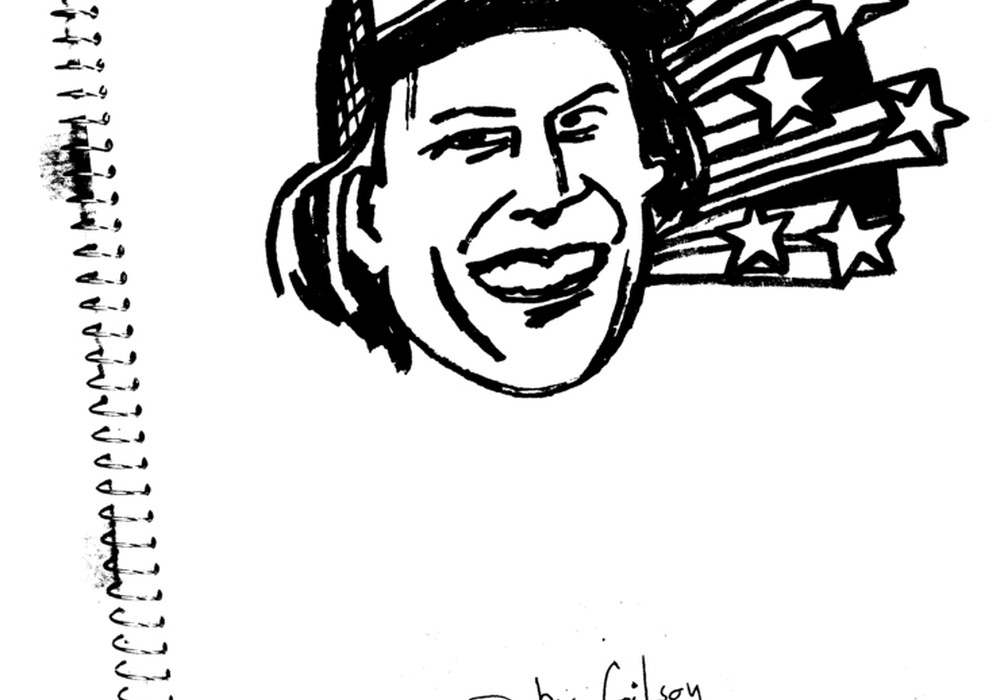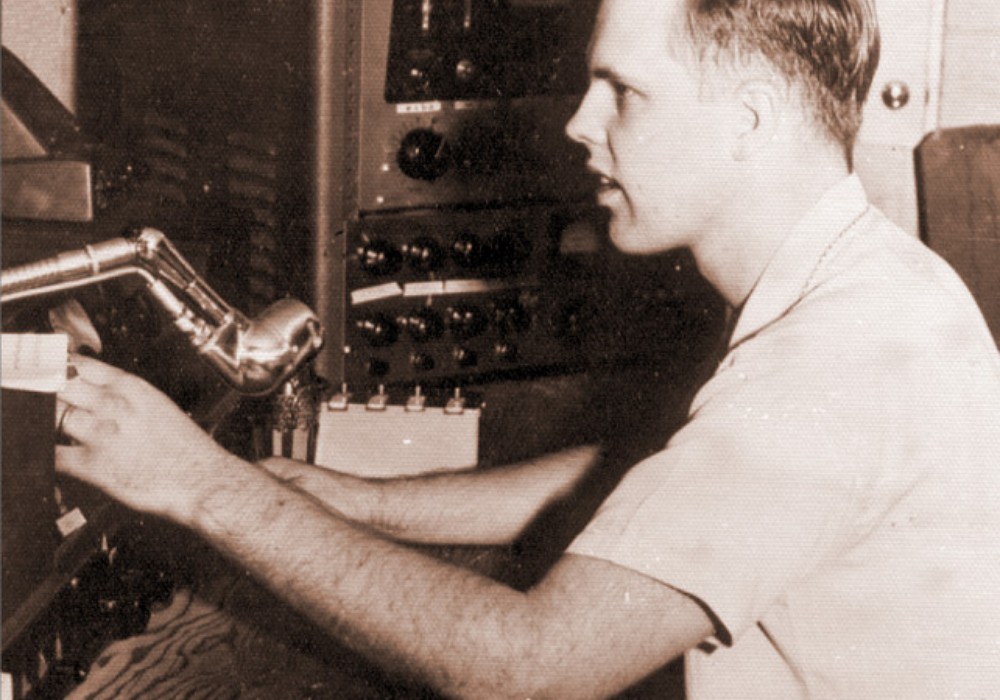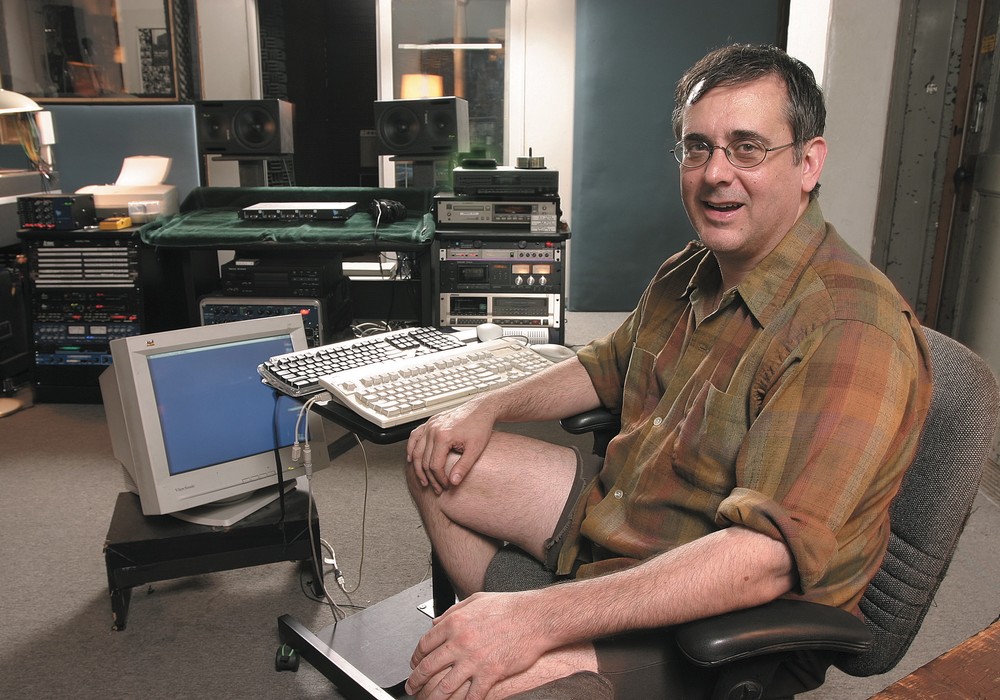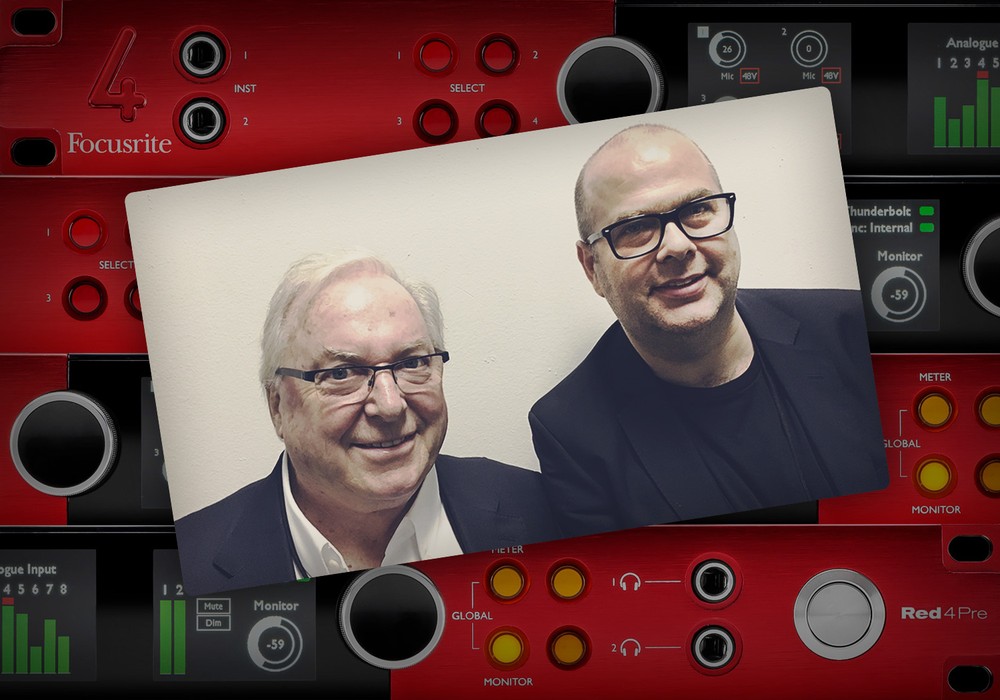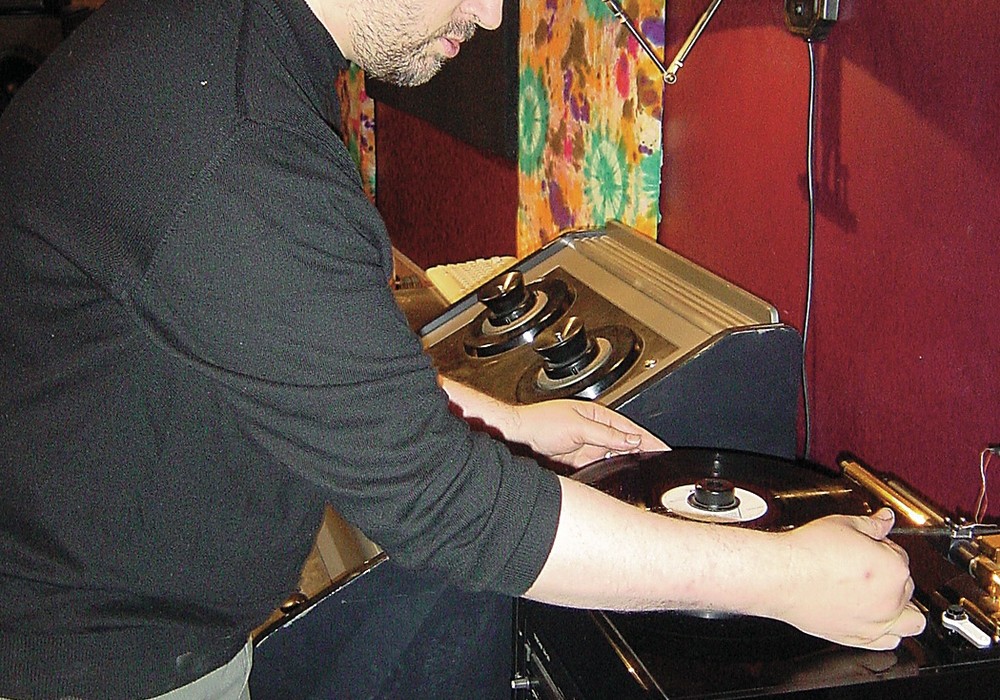"It feels so good to be back on the road again," reveals a recharged Daniel Lanois, as the tour RV he's been traveling in merges onto highway 403 just outside of his former hometown of Hamilton, Ontario, Canada. For the two previous nights, he, vanguard drummer Brian Blade and an assortment of special guests played a pair of triumphantly moving and intimate "homecoming" concerts here.
First and foremost, Daniel Lanois is an artist: a painter, photographer, thinker and storyteller, though he is best known as a musician and producer. He began his journey into music at a young age when he was given an ultimatum by his music teacher: Choose between learning the pedal steel guitar or the accordion. Many moons later, the cosmic, antiquated, weeping instrument that is the pedal steel can be heard on Shine (Anti/Epitaph), a record of a haunting, relaxing and engaging hybrid of psychedelic folk, slow driving pop and instrumental songs. It is his first proper album in a decade.
Between and long proceeding those ten years, Daniel Lanois "the producer" has been a conduit and source of ideas — a perceptive human microscope calibrated to aurally identify, display and enhance a fellow artist's talent and methodologies in the studio and beyond. He himself calls his job "soul mining". He is also adept at experimenting with technology — a "sound miner". In fact, it was his curious manipulations of sound in the late '70s that triggered a homing beacon of sorts to Brian Eno [Tape Op #85]. At the time Eno was preparing to delve further into ambient works, hoping to find a recording facility in a modest yet unlikely and distraction-free urban area whereby he could work with the utmost sense of freedom. A project recorded by Lanois happened to cross Eno's path and pique his ears. Everything then pointed towards the autonomous, ultra-blue-collar, back-boned steel-making city of Hamilton, Ontario, Canada, a recording studio on Grant Avenue and its owners and operators-collaborators, the brothers Bob and Daniel Lanois. Together Eno and Lanois would break ground, polish listeners' cochlea and inspire countless others with albums such as Ambient 2: The Plateaux of Mirror, Pearl (both with Harold Budd), Ambient 4: On Land, Apollo: Atmospheres & Soundtracks and the Music For Films series.
It was during this period (lasting until the mid-'80s) that Daniel Lanois would exponentially develop his craft as producer, engineer and musician. He would also acquire a further understanding of the concepts of communication — a key ingredient to translating and fortifying talent onto record. Eno, having produced and worked with artists such as Talking Heads and David Bowie, was approached by an Irish band by the name of U2 to produce their next record. Eno, with an increasing interest in other mediums in art at the time, confidently suggested the hungry and inquisitive Lanois to the helm of the project, as he and the band both shared a vision of "building the studio around the band". Lanois was then 32, yet already sporting a modest, impressive resume of production credits.
U2's The Unforgettable Fire propelled Daniel Lanois to a status that would allow him to travel and absorb the world's varying musical cultures. From then on, Lanois would produce further albums by U2, as well as masterpieces (ranging from organic sounding to hi-tech productions) by Peter Gabriel [Tape Op #63] (So, US and engineering the Birdy soundtrack), Bob Dylan (Oh Mercy, Time Out Of Mind), Emmylou Harris (Wrecking Ball), the Neville Brothers (Yellow Moon) and Robbie Robertson, as well as Lanois' own "solo" efforts Acadie and For The Beauty Of Wynona.
There is an arguable misconception that any Daniel Lanois "production" involves a sort of an aural "trademark" or "stamp". Most of these albums are rich and dense with sonic scenery and atmosphere, the kind that evoke nostalgia, and some might also include his talented guitar playing (which is certainly unique). Yet the "stamp", in fact, is the intense, raw, neuron-firing electrical-emotional passion that gets communicated and passed on via musician to Lanois to recording medium to playback device to listener. It is unquantifiable — it can only be felt. And it is up to the listener to have their receptors set to "on" or "off". There is no in-between. Another production tool of his is the ability to identify an amazingly talented musician and invite them to partake in a recording. A Daniel Lanois production, when applicable, will include musicians from varying parts of the globe, who bring a completely different perspective to a certain genre of music, thus taking one's project to a higher level.
To this day Lanois has retained a hard-working attitude and ethic. (Backstage after one show, an old friend and bandmate recounted how after their bar gigs, Lanois would continue practicing the guitar while everyone else partook in ritual partying.) These traits were, no doubt, planted in him from his days of growing up and having to fend for himself financially. The style even shows in his guitar playing — a rugged, native Neil Young-meets-Jimi Hendrix type of assault on the strings — chopping away, hitting notes at every angle and part of his hand possible.
The RV sails towards London, Ontario, the next destination on the Shine tour. Like the famed eccentric piano player Glenn Gould, he occasionally wears a pair of black gloves to protect the hands (or the "gift", as he calls it) from possible unnecessary wear and tear when working out (which he does lightly on and off throughout the day) or simply handling things. At the moment, Lanois occupies the small humble kitchen section of the RV, restocking various items. When speaking, he sometimes personifies things, making references and metaphors to things being akin to kitchens and cooking. His shows, in fact, can be referred to as being kitchen parties, where friends are invited to play and sit in the periphery onstage, much like in the same manner as the old days when his family in his native Quebec would gather in the kitchen and sing songs.
The hour or so drive was an idyllic time for Dan to lay down some thoughts for Tape Op. Even before I can suggest a method in which to minimize the sound of highway traffic and wind in order to capture our voices more clearly, his attentiveness and sharp sense of focus immediately come into play. He picks up the cassette tape recorder and thoroughly examines it like a curious scientist with a new sample. In this case, he looks for the small built-in microphone. Upon discovering it, he decides to hold the recording device himself, placing it in close to me and to himself when it is time for either of us to speak respectively. He comes across as both a mysterious character and an accommodating, warm person.
At times like these, one must always be recording. This is one of Lanois' major virtues. Always record, for the moment that's needed might otherwise slip by forever. A Daniel Lanois recording will likely contain some highly interesting sonics occurring, but the number one ingredient is always passion. (His sonics, however, certainly surpass convention.)
I was wondering about something you said at the SXSW conference — something about how and why a studio can be intimidating to an artist — that the musicians themselves should have ease of access to be able to operate equipment in addition to the engineer/producer.
Well, I think some of the functions in the studio should be regarded to be public functions. Knowing what the arrangement of the song is — that should be made public. The clock positions of your recording system should also be made public. So that the people in the room can educate themselves as the work is progressing. For example, if the guitar player hears a point in the song where he feels he wants to do a repair or have a point to come back to, it's nice for that person to be able to say, "Could we go to number — 2 minutes 37 seconds, please?" and so the engineer knows what he's talking about. With the wonderful advantages of modern day technology, one of the things that has not improved seemingly is exactly that — the communication system. So it has become more elitist, in a sense that the operator of the Pro Tools system has a rack and has a chair and has a job and is getting paid and perhaps the musicians are not included in the process. So we've kind of taken a few steps back in my opinion. I always increase communications systems as much as possible and that's what leads to good work. Some of my best work has been done in places where everyone was speaking the same language.
Even back in the day, you and brother Bob began experimenting with the idea of the "open concept" studio — to have the studio built around a band.
I grew up in a conventional studio environment through the 1970s. The usual control room — a piece of glass and musician's room. And I lost interest in that in the late '70s — it became kind of laughable to me. First of all, the amount of time people would spend getting sounds was unappealing to me. Someone would be out there beating on a snare for eight hours — somebody in the control room thinks they're a genius by equalizing it somewhat and I got fed up with it. I thought, "This has nothing to do with music." I also got tired of somebody trying to talk to somebody else in the studio and they're waving their arms and their microphones aren't on and their frustrations would build. I thought [about] why these people don't have problems when they're up on stage, and it's because they're relatively close together and there's no glass, no segregation. So I became fascinated with recording in an open room. I started that in the early 1980s in Hamilton. I used to get use of the old library in Hamilton — it was disused at the time — and they gave me access to it for several months. I recorded a few different bands there and it was great — I treated it more like setting up for a show and we were using more of a P.A. mentality to recording. Harnesses — put that drum over here, bring the microphone over — you know, treating it more like sound reinforcement, like you're doing a show on the Friday and this is Thursday — you gotta get your set-up going. And I found that it increased communication.
Everybody was listening to the same thing. Musicians were hearing their instruments in the room and the engineer would also be hearing the same thing. There's a little bit of a risk involved in the sense that the engineer can't be listening in complete isolation from the player — and you get used to that — you wear cans and what not. I got very musical results out of that system — that's what we did with U2's The Unforgettable Fire essentially. We had a couple of different band rooms giving us a lot of flexibility — the control room became the main recording room where we did all the vocals, all the overdubs were done there. It was kind of the brainstorming center. Over the years I've realized now that the brainstorming center is really the great arena of creation, it shouldn't belong to an engineer and producer, it should be the room where all the smart people get to hang out. That's what it was about as I first said, I got tired of head-banging and trying to equalize a sound for hours, somebody hitting a tom- tom for too long, that kind of thing. I wanted more of the jazz music school of thought where the kit is what it is and it's the engineer's job to document the thing — it's not about some incredible transformation or anything! I found that keeping people close together physically, I got more musical results. You could still isolate amplifiers and still have little hidden corners and DIs and whatnot, but you don't want to make too much of that — it should almost be like the kind of thing that goes to your recording system and you don't need to have a lot of discussion about it. And further to that, I found by designing a recording environment specific to a project, [it] paid respect to the project. It was like, "Okay, this is important — we're going to do something great — we're going to build a custom set." So you'll feel special and think, "Wow nothing like this has ever been done before, we're not stepping into someone else's sound — this is our own custom work." That was the spirit behind it. I'm moving out of that, by the way — in my mind I'm moving into another direction now, but that interested me to the mid 1980s to a few years ago. I'm still using it but I'm moving onto other ideas now.
You are a teacher as well? I think it's an integral part to being a good producer — to be able to pass on ideas and methods to others.
Well, in my world I still take people on all the time whenever I need people. Adam [Samuels] [Tape Op #37], who is doing sound with me, is a young guy and he wasn't doing this four years ago. But I knew that he was hungry, smart, had good musical taste and I sensed that he would respond very well to a teacher- student relationship. So I've been teaching him everything I know. He doesn't have to be taught what good music is. He just needs to be taught, 'How does this connector meet that one?', 'What do we do here?' and so on. Anybody can learn that, and it's just a matter of paying attention and writing stuff down. It's a great thing to do just to pass on whatever bits of wisdom I've picked up on along the way — I like doing it and I like working with young people. It's kind of a young person's position when you think about it — coming up the ranks into engineering. I like working with young folks because they're just hungrier. I have enough experience to steer them away from "sand traps" so I keep an eye out on people that I work with — I give them some rope. Also, I learn a lot from young people because I like to work with idealistic music listeners — they turn me onto records and a way of looking at the world that I wouldn't be able to see.
Well, people should never allow themselves to become set in their ways.
I don't know if I would call it keeping one "thinking young" — they just keep you interested. One of the great ingredients that we have to work with is to have the ability to get excited, and youth is often connected with that. But in fact, if you're ongoingly fascinated you'll keep being hungry for information and the ability to get excited is very important to me. I have it, and by having Jen [Tipoulow] and Adam around with me we get thrills — we brainstorm at night — it's really cool.
I've wanted to point out that there are certain records you have worked on which are fantastic and inspired- sounding that don't seem to get talked about much. For example, the Scott Weiland [from Stone Temple Pilots] 12 Bar Blues disc.
Well, Scott sent me his record with a view of my adding to it and maybe mixing it. And I thought it was fabulously interesting and I thought it was the most inventive work I've heard in a while. On the strength of that, I said I'd mix half of the record. I did an interesting setup, which is something that I always do now if possible. I set up in the main control room to do the mixing. And then we do an extra console in a side room. Let's say there's a little booth or a kitchen next to the main control room — I set up another console in there, usually a 24- or 36-channel compact console, maybe a Mackie or whatever. And that person in there gets all the same information. They get their own processing gear but they get all the tracks. So while I'm mixing in the main room, someone else is mixing in the side room, but I don't know what they're doing. And during Scott Weiland it was Mark Howard who was in the other room. And it's, like, no-holds barred. Whatever you come up with, I'm interested in listening to it. So I'll be working on a mix, an hour will go by and I'll go into Mark's room and say, "Let me hear what you've got," and there might be something in his mix that is better than what's in my mix, like maybe he's got the drums sounding better or the bottom is better at which point I will say, "Don't change anything!" I have two faders on my main console giving me access to listen to what he's up to. So I bring that up. And if he's got a better bass sound than what I do, we print it on the main recording system. So it's just the way of raising the standard a little bit. That person, the "renegade" person, they might hit on a cool vocal echo, so you use it. It's sort of a buddy system. I do that with Brian Eno as well when we're working together. We set up the "manipulation-station" in the room and that's the station that Brian usually sits at and he wears headphones and he goes bonkers — he tries the craziest stuff and every now and then we bring up the two faders on the console and see what he's up to.
That's how the background vocals to "It's A Beautiful Day" from U2's All That You Can't Leave Behind — that's how we came up with that sound, it was an Eno manipulation. Eno and I have always done that. Plus, come in the studio early and knock something together for the band for when they walk in. The thing I've done for years — as you're going along, and you hit on something nice, let's say a vocal effect that seems cool, you document it, you write it down — what the echo is and this and that. And that becomes 'vocal sound number one.' Put it on the wall. And for number two and three and so on. So for a specific project, you keep track of your most interesting sounds relating to that project so it gives that record a chance to have its own unique sonic personality. You don't wait until you're mixing to think everybody in the room is going to be a genius inside of an afternoon. In fact genius is small pieces — as you make your discoveries, you document them, you make your menu, and that becomes a menu for that record. Even if you don't end up using that very mix from that day, you at least document it, put it down and say, "Okay, here's the plan for the echoes"' and whatnot.
That Willie Nelson record, Teatro — we would record a track, do a couple of overdubs, and while we're listening back, we'd lay down a mix. And I would say to Mark, "That sounded great, Mark, let's try another one, lemme help you with the intro and I'll do the fade." You knock one out, and that record is made up of those mixes. So the spirit of the moment goes a long way. So what does it cost you? You know — a four minute stretch of a DAT to lay it down? Its probably one of the most valuable lessons — get yourself along the way.
Your new record, Shine, is highly interesting — sort of complex yet simple sounding, with great depth and extreme clean clarity to it.
We took an 18-wheeler [truck] full of equipment to Mexico — that was complex in itself! [laughs] We were dealing with immigration and customs, having to bribe people and so on. [laughs] We set up the same kind of "renegade" setup — we had an Amek Tac console — a very compact 48 channel — like a high-end P.A. console — and it was great. I loved it down there. We had no magnetic field problem. You know about magnetic field?
Somewhat...
If you play a single-coil guitar, like a Fender Telecaster, in some places — Hamilton, by the way, is one of the worst places in the world — you get this incredible buzzing and humming coming through your guitar. It's the pick-up picking up what all that exists in the air — it's called magnetic field. It's created by high-current power lines and streetcar systems and factories, just lots of wires creates magnetic field. And in Mexico — no magnetic field problem — incredible! It was the purest electricity that I have ever experienced working with. It's the kind of stuff that never gets talked about in other magazines — it's the quality of your electricity that has a lot to do with how your guitar amps sound, how good your computers run and all that stuff. So as someone who has moved around a lot, I look for really good power and low magnetic field problems.
Another strength to your production values is on dance/beat-oriented music. The Luscious Jackson Fever In, Fever Out album is another album that just sort of came and went.
Well, I've always been interested in rhythm. It happens to be part of my musical "gift" — I'm a very rhythmic musician. In the early days I played in funk bands and I have the gift for that. It happens not to be where I go musically for songwriting, so it's kind of a contradiction, but I love the idea of rhythmic music but it's not what I'm known for — for whatever reason. For the Luscious Jackson stuff we did most of that in the drummer's apartment on 14th street [in New York City] where they were rehearsing. I thought that room had a vibe to it so I said, "Let's just start here." I shipped some equipment down from Canada — my brother Bob did the set-up and we just kind of worked with what they already had, and chipped away at it. We got a lot of nice tracks in there because they were physically really close together — there was nice vibe there. The shape of rooms — it's an ongoing mystery to me about rooms and their musicality, but I've pretty much come to the conclusion that rooms with really tall ceilings that are kind of rectangular-shaped, like Sun Studios — tile on the floor — not carpet — tile or wood or preferably tile on concrete, like a lot of the old BBC studios are like that, orchestra rooms, including Tuff Gong in Jamaica — those seem to be the most musical and dense rooms.
The room becomes the engineer and musician at times...
It's the kind of thing that never really gets talked about — how a room becomes the extension, if you're a guitar player, of your amplifier. Your amplifier will not sound the same in every room you go. I suppose an extreme example is if you play outside, your amp has no walls to play off — it tends to poop out a little quicker, it'll be more bagged-out sounding. But if you're in a really good dense room, like maybe like a big kitchen for example, suddenly your amp sounds twice as loud, twice as good and has more body. So I really look for rooms that are musical rooms and that will be sort of amplifiers of music. Band shells are an example of that — if you sing in a band shell you sound louder than you would if you were just standing out in a field. So some of the most musical rooms that I have ever worked in have been rooms that have not been designed for sound.
What would have been the most interesting and unique environment you recorded in? I recall that you did some of the first U2 record you and Eno worked on in a castle in Ireland...
Well I think the Mexican set up was the most unique because it was sitting on top of a cliff that somebody had dynamited — taken a chunk out of the cliff and had built this kind of a house with a palapa roof so we were under a palapa roof on a mountain top, but then you can step outside — so the house was half inside, half outside and that was probably the most unusual and creative environment.
Your music/style lends itself perfectly to films. Slingblade is a rather fine example of that.
Well I don't want to be a soundtrack guy, but I like great films. So I always keep my eyes open for a great film. I was lucky enough to write and deliver the music for Slingblade. Billy Bob Thornton and I have been talking about doing one more.
What some people might not know is that besides painting, photography and drawing, you make your own films as well.
Yes, I have my own little film on the go — it's provisionally titled Silvio. It's a little science-fiction film, about a little baby who comes from somewhere else in the universe and comes to this planet and his journey through childhood, teenage years and adulthood and just sort of his way of looking at the world, and I kind of do it with just a little tabletop project. I use photographs, dolls and by hook and crook I make my own films. It doesn't have a home right now but may come back into existence after this tour.
Of course you like using old and obscure equipment, like mics, old cameras, and whatever other toys that have a fine lower or higher grain or marred sonic quality. The need for "high fidelity" doesn't really matter in the process, does it?
I think what's probably most important is that you have a reliable "carrier". The carrier would be your recorder — whether you're working with picture or sound. Something reliable and musical. And there's so much to choose from. I use a Canadian machine called RADAR. It's a computer-based system and is very easy to use and very reliable. We have a good relationship with the company and they've been kind to me, so that's my system. I also still have at home my 2" 24-track, 1" 8-track — I've got all the best pieces over the years still. I find that once you've decided on your reliable carrier, then that's when you can do just about anything you want. Whether it is cheap microphones or expensive ones. As you know, sometimes I'll go to a corner store, like a 7-11 or Mac's Milk, and I'll be impressed by the look of a surveillance camera, like it'll be a four-frame split and I'll be like, "Woo!" The color will be completely wrong and it'll have a graininess and you'll never have that look from a hundred-thousand dollar camera. As they did in [Oliver Stone's film] Natural Born Killers — they'd have a low-grade stock footage — if you dig a look, then the responsibility then is to make sure you document the look on a high-grade carrier.
Let's hear about some of the people who have worked closely and extensively with you, all of whom have now gone on and continue to make some monster records — Mark Howard, Dave Bottrill [Tape Op #19] and Malcolm Burn [Tape Op #35].
Well, all of those people — Mark, Malcolm, Dave — first of all, they're all smart, so they started with a "full deck". But they all came from different places. Mark came from P.A. so he was a travel-dog — he had a lot of road experience before he came to work with me. That proved to be a huge asset. He was used to dealing with emergencies, so he was kind of perfect to travel and do renegade set-ups with me. We just took it to a whole other level — I could really rely on him to chase a problem. Like when we did Willie Nelson's Teatro record, I was able to telephone him from Willie's bus — Willie, Emmylou [Harris] and I were working out the arrangements, so I was able to communicate with Mark and say, "Here's what we're going to need, set up the drums here" and so on, and by having worked together for so many years and doing the renegade thing we had a great communication system. I'd say Mark's strength back then was all that great P.A. experience. Currently he's got his own rig in L.A. and is doing some great records. Malcolm Burn came from a musical background — he was a player first, studied piano as a kid and whatnot and I was impressed with his 4-track home recordings. They were fantastic to me. And on the strength of that I invited him to engineer the Neville Brothers [Yellow Moon], Bob Dylan [Oh Mercy] and my first record [Acadie]. I cut a package deal with him. I thought he had a lot of imagination and was the kind of person that would be able to follow my footsteps and break the usual rules. Malcolm would do a cool thing — he would engineer and play at the same time, he always had a little keyboard there and I could really rely on him to come up with sounds and what not. He was an endless source of ideas and vision and that was great. Dave Bottrill, he is one of the world's greatest memory banks. "He was a quiet man... [laughs] He came to work with me in England because I needed somebody who could remember stuff.
I was working with Peter Gabriel [on the 1986 So record] and there were a lot of settings to write down — I just needed someone who was absolutely dedicated. I called Dave in Hamilton and that's what he did. He just wrote everything down — he wrote extensive diaries and workbooks and not a stitch of anything was ever un- documented. And then Dave had a knack for the technology and Peter's always got the latest computers or whatever, so Dave lashed into that world with Peter. So when we finished that record, I wanted to get out of England and I said to Dave, "Listen, if Peter will take you on, you'd do much better here" and he just escalated from there. He got really good with the technology and so on and now he's a master — all the power to him.
You've worked on albums for long periods of time, especially the latest U2 one, which was something like at least a year in the making in Ireland. Then came finalizing Shine. And now you plan to record your next one in between shows and release it in something like eight months from now — that's kind of punk rock.
I have a dream that I share with a lot of friends, which is, "Wouldn't it be nice to go into the studio after having been on the road playing songs?" You wouldn't think it was such a genius idea, but it doesn't happen that way anymore. Back in the 1940s and '50s people would work up songs — like all the early Rolling Stones ones, too — they'd be on the road, and when the song would get good, they'd go into the studio. So the reason to record would be to document, and I'd like to work up new songs live and go in and knock them out quite quickly within the course of a few days just so I don't suffer from too much brain damage from extensive studio work. But the reality of the situation would probably be that I would use some new songs from that technique and some things that are already in my archives that are really beautiful, but unfinished — more sonic-based things.
If there's one ultra-definite thing you have reiterated while we are on the road here talking on and off throughout the voyage, it's that the "record" function of my tape recorder should always be happening.
I record all the time. Reason being that if I hit on something I regard to be magical, it's not likely I'll be able to come back to it. People change, the room changes, molecules change. [laughs] If there's something special, I lay it down and I have an extensive library that Adam helps me with. I have a "melody orphanage", the "beat orphanage", the "sonics" and sort of more "filmic" corner of the library — things that we started and never finished.
The New Orleans place — Kingsway. Originally you were going to sell it with the equipment but you decided to take it with you instead after all...
I've still got all of the equipment. I'm probably going to sell some gear in the next few years — I've got a whole mess of consoles.
What's the one that had graphic EQs in each channel? Was it customized? I've always wanted to use one in that configuration.
Yeah, that's the API out of the Record Plant in New York City. It was an available EQ, called the 560. I think it might be slightly customized, though. Ergonomically speaking, it's a stroke of genius because the graphics are directly inline with the modules, up on tilt, where the meter bridge would normally be — so as you're looking at the top of the rail, you'd have a lovely graphic on a 45 degree angle staring at you so even from 10 feet away, you could see what was going on with that channel. You don't need to be hunched over trying to figure out what the parameters are. As you may have noticed, there are certain types of microphones that I like to use that are very inexpensive — I still like a Shure SM 57 on a guitar, I've been using the Sennheiser 409s. They're out of production, unfortunately, but at the time they were like a $200 microphone and they've got a big capsule and they're really great. If somebody can get their hands on a 409 — in fact, in a pinch, that's a really great vocal mic. It may actually sound better than an expensive tube or condenser mic.
I notice you use Shure mics quite often, be it live or in the studio — and sometimes I swear I can hear them entirely on your recordings in terms of the drums. They're no doubt a reliable sturdy workhorse transducer.
Definitely. I've been using Shure mics for years and years, ever since I was a kid when I was in a bunch of bands playing around Hamilton and other towns. I first fell in love with the Shure 554 — it was a pistol grip type of mic and it sounded really great and looked really cool. It was a microphone from the mid 1960s — it had a great sound and feel for soul music. It's a mic that I want to reinvent someday. The thing about Shure products is that they're very, very affordable cost-wise, and they go a long way. They're just great tools to have. I've always used some form of a 58 model, be it the Beta 58 or other incarnations of it, on Bono's vocals on all the U2 records that I've done during the past twenty years.
Were you ever approached by manufacturers to test stuff out, in terms of development?
The only company I've ever been involved with in terms of design was Peavey when I was in New Orleans. I helped them design an equalizer. It's a great company. They make a little guitar amp called a Peavey Solo. To this day it's one of the greats — it runs on batteries so you can do a street thing with it. When your batteries start dying down it kind of picks up a fuzzy warm tone. In the studio it's surprising how sometimes the Fender Champ is my best amp — a little tweed Champ I have from the late 1950s. I think there's some kind of wisdom to there only being one speaker so you're only going to mic one speaker. And by having four, let's say, you then invite sort of a hazier sound from the neighbor next door. By just having a single speaker, your sound is more focused, real clear and doesn't have any debris around it. Fine-tuning your equipment and getting it to a place where it really has your personality is a very big part of it in my approach. I usually try to do my setups, and once I get my sounds I leave them. I use the same rig for all the overdubs.
How about broken stuff? Do you seek that kind of thing out?
Yeah. I've got a few broken equipment stories. When I went to work with Peter Gabriel we pulled out his old tube [Telefunken] U47 out of the closet and it had — I think it was such that it patched right into the patchbay — and the microphone had something wrong with it, all it had was just top end. But it was a very nice top end. I said to the technician, "Could you leave me the broken cable? But could you then have a second cable from the microphone that is fully operational, that has full range of the mic?" And he did that, so I had the broken sound on the fader and on the next fader was the full proper sound which I brought up and I would season to taste with the broken one, and that was my equalization for Peter Gabriel's vocal on So. It meant that I didn't have to crank up a bunch of hiss on an EQ - I was getting it from this broken cable which had this beautiful top end! It was almost like a filter sort of system.
I always believe that slight variations that deviate from normality make a unique feel — even if it's very minor. It's a mathematical art kind of thing. What's your take on drums overall?
I think the key to getting a good drum sound is to take an interest in the drums themselves. Assuming that you have your own shop, it's good to keep a couple of kits around and nurture the tuning and different bass drums for different applications. Drums seem to have a personality and they have cycles — a drum will speak very well for a few months and then it's like, "What happened to the snare sound?" Sometimes it's better to just retire that drum for a while and bring in another one that's on good behavior.
It's kind of like tube amps — say, for a guitar — a vacuum tube blows out and you replace it, or some little other thing has to be replaced and soldered in and somehow from there on, the amp loses its "mojo".
Yeah, that's strange how that goes with equipment! I hate to change the strings on my pedal steel guitar for that reason. It gets to a place where it's really behaving but you have to because it's got bending strings — eventually they'll break.
When you have a monster world-class bass player like Tony Levin [Tape Op #33], whom you've worked many a time in a production situation, how do you harness their skills?
In the case of Tony, it's a matter of developing a great relationship with someone like that. So I did something for him that had never been done before. I set up a little "station" for him, with his own recorder. So he had his own little headphone station but he had a cassette recorder, like a little blaster. And at any given time during a session if he wanted to lay something down, like maybe if there was a cool mix or an idea, he would sort of make up his own work compilations and he was really thrilled about that. He said no one has ever done that for him before. He didn't have to be waving his arms at an assistant trying to remember what was what. If he played something cool and wanted to be reminded of it he'd wind back and learn it, because the headphones were plugged right into the blaster. I also got a really cool sound on him. We had a Music Man bass that we put through an octave pedal then I hit an SSL compressor dynamic system and went, like, completely out of control with it. We had the bass on this really sticky sound, and that's what you hear on [Peter Gabriel's] "Sledgehammer". The way I work with Tony is let him go, let him play, and when he hits on something that's unique and could really give the song a piece of personality I would wind back and say, "Tony, listen to this. Could you learn that part and play it in that place every time from here on?" He's like anybody else, he likes encouragement, he likes if you spot out a magic moment...
Jerry Marotta [Tape Op #33] did the drums on one track ["Red Rain"] on So, but who was it that did the awesome percussion on the album?
Manu Katche. With Manu — well, on one of the songs there was this "Sledgehammer" groove which was kind of an early hip-hop thing and we had a lot of rock drummers come through and there was nobody that could play that feel. A friend of Peter's recommended a great French jazz drummer named Manu Katche. He rolled in and I said, "Can you play this?" [Daniel vocalizes the beat.] It was a real sexy kind of swing thing, which later turned into hip-hop, but at the time that's the only way I could describe it. He went out there, and knocked it out in one take. But he wouldn't have been able to knock it out in one take if we didn't have our technical work done. You'd have to say, "Manu, that's really great, now — stop while we plug in microphones." So just to reiterate my philosophy — you've got Manu Katche playing out there, in four seconds you better be recording. In order to record in four seconds, you need to do about three days of work — all the preparation, trying out different microphones and stuff. It's not so much about the sound of the drums — it's about getting your technical wires organized so you're not wasting an artist's time.
So in the past eighteen years you have moved about the globe and set up studios — from England to New Orleans to the Los Angeles basin. Was there an appeal to a place like L.A.?
There was no appeal to L.A. other than that it was closest to Mexico. There is a lot going on down there, though — a lot of bands, a lot of cool clubs, so if you want to hear music it's a pretty great place. But probably the shop that I miss the most is Teatro. It had enough space that you could really turn it into anything you want. It had a stage — you could actually have a live performance going on. Did you ever see it?
No, just through pictures. It was an old Mexican porno theater in Oxnard [California] near Ventura?
It was a beautiful place — a great, great, great workshop. And I'm the kind of person that likes to leave things set up when I get started on something. So my idea was to have different little workstations. We were all messing with things like 16mm film projections and a surround sound system. We would trapeze in some speakers, like suspending them from the ceiling. It's a very tall place — like 45-foot high ceilings. Then we had a rear P.A. and some front sounds and Mark had a way of getting to all the different speakers with the different sounds so it was really cool for that kind of experimentation. We could have wedges — it was like a stage where you could radically change your monitoring tactic. Sometimes that's a good thing to do in the middle of a workday of recording. "Okay, shut off those front speakers and let's put them in the back and let's liven up the place a little bit." So you're not sort of looking at things through the same perspective all the time. I find that bass overdubs and certain other ones, you want to crank it up a little bit and juice up the room. We actually had some live performances there, we would invite an audience a few times. In fact Brian Blade's first record, [Brian Blade Fellowship] was done that way. We recorded for four days and on the fifth day we invited an audience. In the presence of an audience, everyone is on good behavior and we got some great results. So the studio could be turned into a performance place with an audience without upsetting the recording — I think that's a better recording studio. It gives you that flexibility to experiment. It had a beautiful screen so we would do large screen projections. It's a magic place. I think in retrospect now, that's probably the most fun, flexible and visionary place that I ever worked in. I highly recommend that kind of arrangement for somebody else. There are lots of disused cinemas around, or old soundstages and what not. Just about every small town in North America has a cinema that's closed down, even Hamilton. And that's it — it's a perfect place to do a lot of great work.
You had it for a few years, yes?
I had it for about four years. The New Orleans place [Kingsway], was amazing. That was largely about the architecture, the beauty of the architecture and countless amazing sounding rooms. It was very flexible in that way — you could set up a drum kit in half a dozen different rooms relative to what you needed. I finished my New Orleans chapter, and I sort of got into a little trouble by getting in with the wrong crowd. Besides, I don't want to be the owner of a recording studio. It's a very bad idea. It took me way too long to realize that. I don't know how I ever fell back into it but I did - I'm not in it anymore. So I was just looking for a shop. I'm old school. I turn up for work, and I've got various projects going and there will be something on that desk that I like, something visual. I keep that desk set up for my visuals, then over here we have the bass rig that never gets torn down. Over there you have the keyboard rig — that never gets torn down and so on. Leave what you like set up and if somebody waltzes in unexpectedly and they sit at the drum kit, you can be recording them in a split second. That's the philosophy. Having seen so many great potential performances squashed because somebody had to run out and had to plug in a cable — I have no patience for that anymore. I like everything to be ready to go. I won't even ask an artist to step into a studio unless all the preparation has been done. I've gotten the gist of what I do, it's not terribly mysterious — just keep stuff plugged in, keep it working. Only good will come of it.
